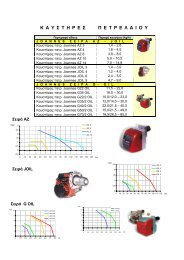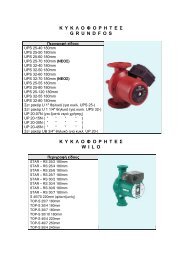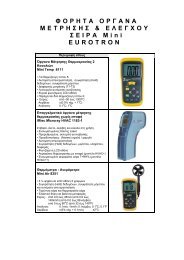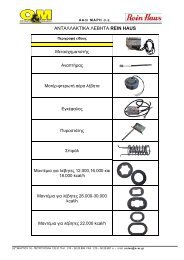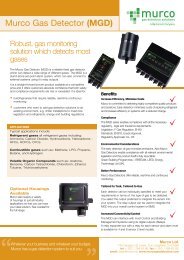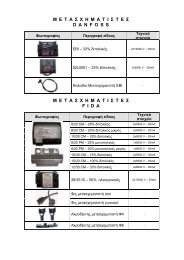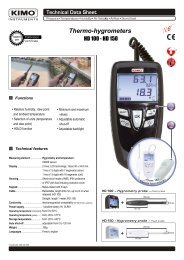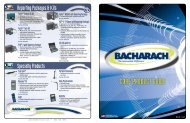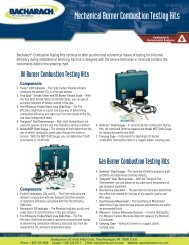MM850402-06 Gas Analysers 3000-4000 - om.gr
MM850402-06 Gas Analysers 3000-4000 - om.gr
MM850402-06 Gas Analysers 3000-4000 - om.gr
Create successful ePaper yourself
Turn your PDF publications into a flip-book with our unique Google optimized e-Paper software.
Instruction Manual <strong>MM850402</strong> ed. <strong>06</strong>4.1.1 <strong>Gas</strong> Sampling ProbeThe sampling probe consists of a steel tube and a handle of thermo-insulated material. A positioning cone allowsuser to place the probe in holes with a diameter fr<strong>om</strong> 11 to 16 mm.The gas temperature is acquired using a thermocouple type K with the junction placed in the tip of the probe.4.1.2 Water Trap & Line FilterThe gas flows through an external c<strong>om</strong>bined water trap and line filter to avoid the presence of condensation andsuspended solid particles in the analysis section of the instrument. A cylinder is positioned at 15 cm fr<strong>om</strong> theinstrument gas inlet it is divided into two parts: the water trap and the line filter.The water trap works using the expansion principle: the gas flow decreases its speed inside the cylinder and itwill cool; the humidity will condense and the solid particles fall down. The section of the water trap must beperiodically drained off to avoid water fr<strong>om</strong> entering the analysis section. Pull the rubber plug (cat. EE650081) andshake slowly the trap to drain any condensation. Push the rubber plug to close the trap hole.The line filter is positioned after the water trap and before the electrochemical cell. Its function is to stop thesmallest solid particles before the analysis. Remember to change the filter (cat. EE650074) every time it is dirty.Line filtercat. EE650074Rubber plugcat. EE650081WARNINGTHE WATER TRAP MUST BE KEPT IN A VERTICAL POSITION DURING GAS SAMPLING. AN INCORRECT POSITIONING OF THE TRAPCAN ALLOW THE WATER TO ENTER INSIDE THE ANALYZER AND DAMAGE THE ELECTROCHEMICAL SENSORS.NEVER MAKE ANY ANALYSIS WITHOUT THE DRAINING RUBBER PLUG. THE MEASUREMENTS WILL BE INCORRECT.WHEN YOU FINISH THE ANALYSIS, REMEMBER TO DRAIN THE WATER TRAP. BEFORE PUTING THE GAS PROBE IN THE CARRYINGCASE, REMOVE THE CONDENSATION WATER FROM THE PROBE HOSE.TO OPEN THE WATER TRAP GENTLY ROTATE THE TWO PARTS: DON'T FORCE THEMTHE LINE FILTER SHOULD BE REPLACED WHEN DIRTY. NEVER MAKE ANY ANALYSIS WITHOUT LINE FILTER AND/OR WATERTRAP, AS IT CAUSES AN IRREVERSIBLE DAMAGE TO THE ELECTROCHEMICAL SENSOR.4.1.3 <strong>Gas</strong> SensorsThe analyzer uses long life sensors for O 2 , CO (H 2 c<strong>om</strong>pensated), NO, NO 2 and SO 2 . The sensor do not needspecial maintenance but must be replaced after the expected lifetime.However a full maintenance and certification of the instrument is rec<strong>om</strong>mended once a year.The gas sensors are electrochemical cells c<strong>om</strong>posed by two electrodes (anode and cathode) and an electrolytesolution. The sampled gas goes through a selective diffusion membrane.17



